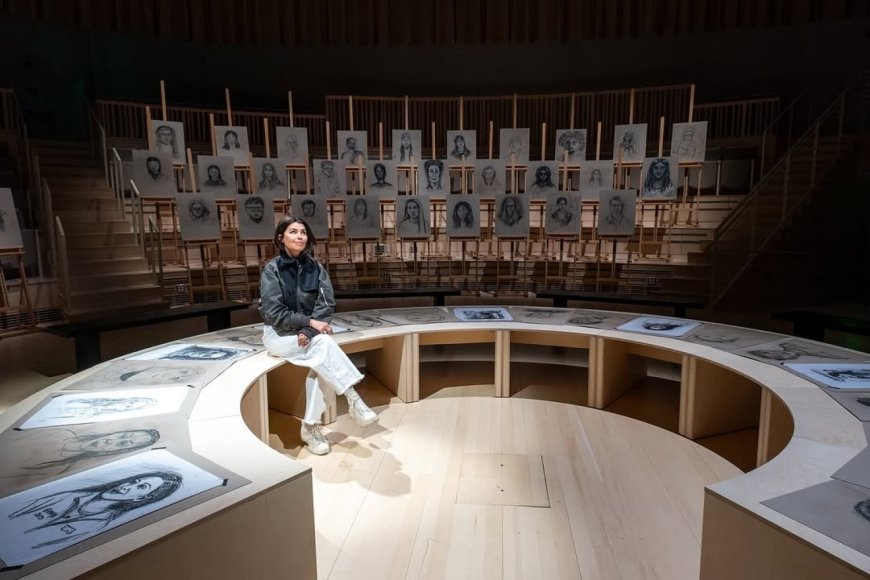Exploring the Artistic World of Es Devlin
Es Devlin, renowned for her innovative designs, creates immersive experiences that bring people together in various settings, from intimate rooms to large stadiums. Through her diverse projects, she blends art, technology, and human connection, inviting individuals to explore their sense of self within a collective space. Her recent work at MIT highlights the power of drawing and storytelling in fostering connections and understanding among a diverse community.

Es Devlin, the winner of the 2025 Eugene McDermott Award in the Arts at MIT, creates settings for people to gather - whether it's a few people in a room or crowds swelling a massive stadium - arenas in which to dissolve one's individual sense of self into the greater collective. She herself contains multitudes; equally at home with 17th century metaphysical English poet John Donne, 21st century icon of music and fashion Lady Gaga, or Italian theoretical physicist Carlo Rovelli.
In the course of the artist and designer's three-decade career, Devlin has created an exploded paint interpretation of the U.K. flag for the Closing Ceremony of the 2012 London Olympics, a box of illuminated rainfall for a production of the Crucible, a 65-foot diameter AI-generated poetry pavilion for the World Expo, an indoor forest for the COP26 Climate Conference, a revolving luminous library for over 200,000 in Milan, Beyonce's Renaissance tour, and two Super Bowl halftime shows. But Devlin also works on a much smaller scale: the human face. Her world-building is rooted in the earliest technologies of reading and drawing: the simple acts of the eye and hand.
For Congregation in 2024, she made chalk and charcoal drawings of 50 strangers. Before this project, Devlin says, she had most likely drawn around 50 portraits in total over the course of her practice - mostly family or friends, or the occasional covert sketch of a stranger on the subway. But drawing strangers required a different form of attention. 'I was looking at another, who often looked different from me in many ways. Their skin pigmentation might be different, the orientation of their nose, eyes, and forehead might be other to what I was used to seeing in the mirror, and I was fraught with anxiety and concern to do them justice, and at pains not to offend,' she recalls.
As she drew, she warded off the desire to please, feeling her unconscious biases surface, but eventually, in this wordless space, found herself in intense communion. 'I gradually became absorbed in each person's eyes. It felt like falling into a well, but knowing I was held by an anchor, that I would be drawn out,' she says, 'In each case, I thought, 'well, this is it. Here we are. This is the answer to everything, the continuity between me and the other.' She calls each sitter a co-creator of the piece.
Devlin's project inspired a series of drawing sessions at MIT, where students, faculty, and staff across the Institute - without any prior drawing experience necessary - were paired with strangers and asked to draw each other in silence for five minutes. In these 11 sessions held over the course of the semester, participants practiced rendering a stranger's features on the page, and then the sitter spoke and shared their story. There were no guidelines about what to say, or even how to draw - but the final product mattered less than the process, the act of being in another's presence and looking deeply.
If pop concerts are the technology to transform private emotional truth into public feeling - the lyrics sung to the bathroom mirror now belted in choruses of thousands - Devlin finds that same stripped-down intimacy in all her works, asking us to bare the most elemental versions of ourselves.
'We're in a moment where we're really having a hard time speaking to one another. We wanted to find a way to take the lessons from the work that Es Devlin has done to practice listening to one another and building connections within this very broad community that we call MIT,' says Sara Brown, an associate professor in the Music and Theater Arts Section who facilitated drawing sessions. The drawings were then displayed in a pop-up group exhibition, MIT Face to Face , where 80 easels were positioned to face the center of the room like a two-dimensional choir, forming a communal portrait of MIT.
What's Your Reaction?
 Like
0
Like
0
 Dislike
0
Dislike
0
 Love
0
Love
0
 Funny
0
Funny
0
 Angry
0
Angry
0
 Sad
0
Sad
0
 Wow
0
Wow
0

















































































































































